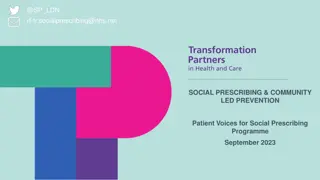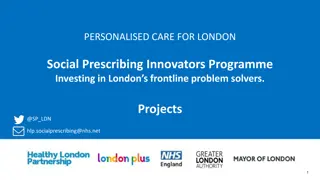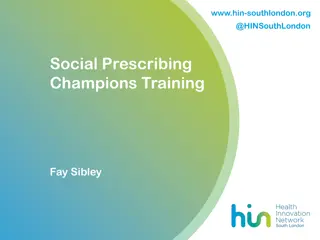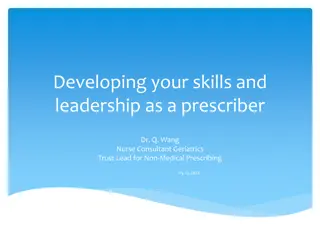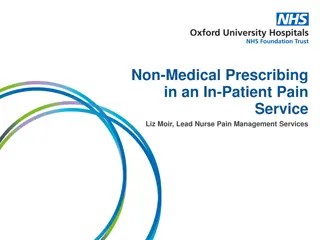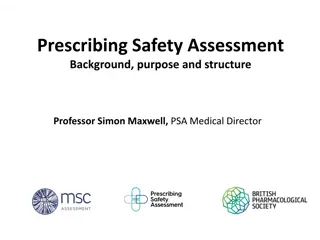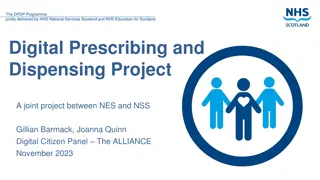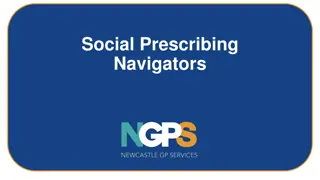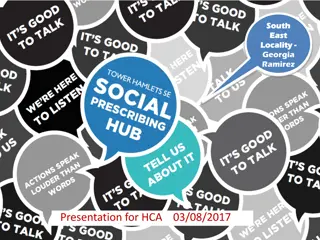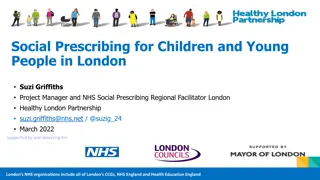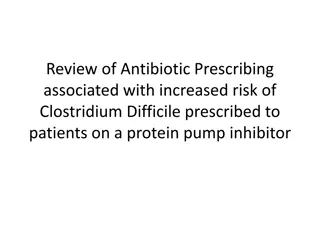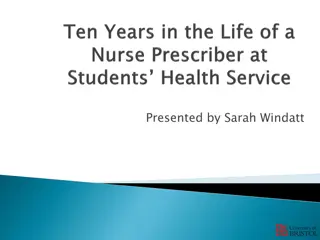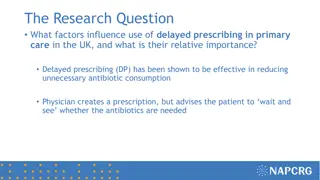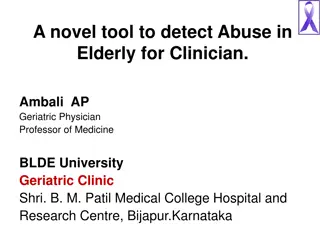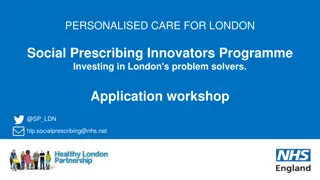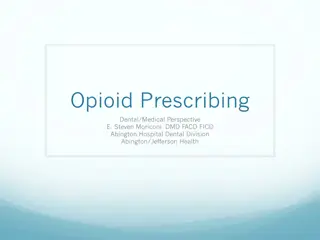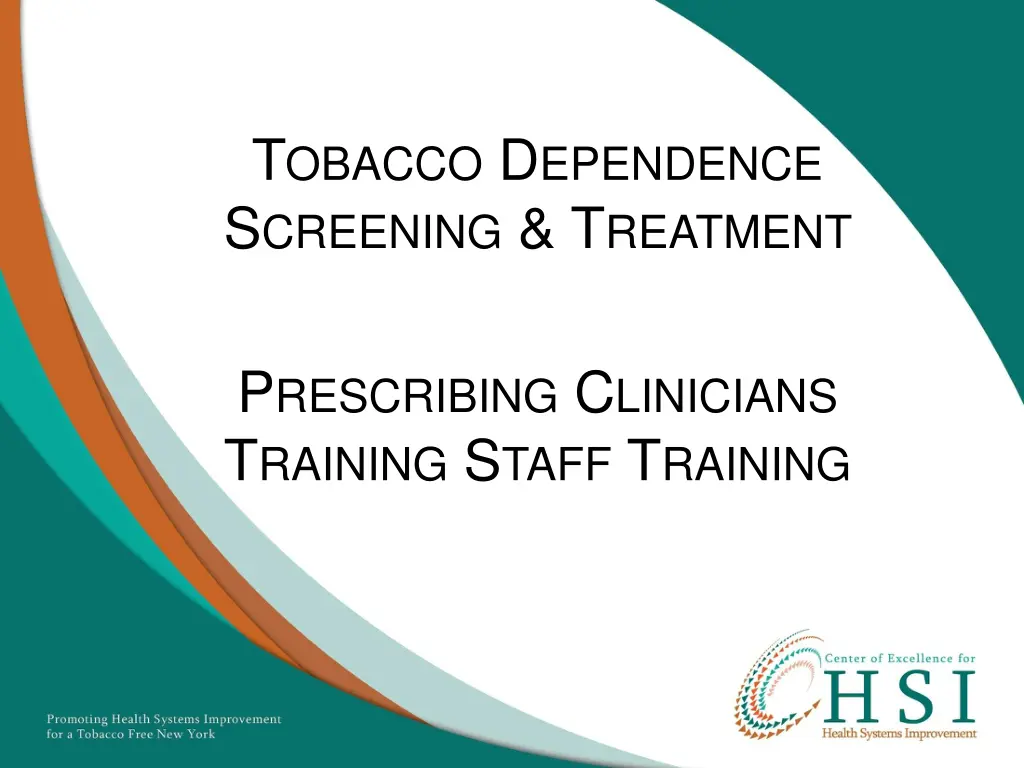
Evidence-Based Tobacco Dependence Screening and Treatment Training
Enhance clinician capacity in evidence-based tobacco dependence screening and treatment through a comprehensive training program. Delve into the integration of these practices into standard healthcare delivery, focusing on chronic illness perspectives, clinician roles, effective interventions, counseling strategies, and reimbursement essentials.
Uploaded on | 0 Views
Download Presentation

Please find below an Image/Link to download the presentation.
The content on the website is provided AS IS for your information and personal use only. It may not be sold, licensed, or shared on other websites without obtaining consent from the author. If you encounter any issues during the download, it is possible that the publisher has removed the file from their server.
You are allowed to download the files provided on this website for personal or commercial use, subject to the condition that they are used lawfully. All files are the property of their respective owners.
The content on the website is provided AS IS for your information and personal use only. It may not be sold, licensed, or shared on other websites without obtaining consent from the author.
E N D
Presentation Transcript
TOBACCO DEPENDENCE SCREENING & TREATMENT PRESCRIBING CLINICIANS TRAINING STAFF TRAINING
GOAL To build the capacity of prescribing clinicians to provide evidence-based tobacco dependence screening and treatment to their patients, ultimately supporting the integration of this practice into standard delivery of care. 2
OBJECTIVES As a result of this training, participants will be able to: Explain how tobacco dependence is considered a chronic illness Explain the clinician s role in the integration of evidence-based tobacco dependence screening and treatment into health care settings Identify and describe the evidence-based approaches for supporting successful tobacco cessation interventions Identify and demonstrate effective counseling strategies to facilitate patient involvement in treatment Identify the necessary coding and documentation for reimbursement 3
TRAINING AGENDA Activity Welcome, Goal & Objectives Tobacco Dependence as a Chronic Illness Clinician s Role in the Integration of Tobacco Dependence Screening and Treatment into Health Care Settings Evidence-based Tools for Tobacco Dependence Screening and Treatment Effective Counseling Strategies for Tobacco Dependence Screening and Treatment Coding and Documentation Closing 4
WELCOME & INTRODUCTION Please share your: Name Agency Role 5
TOBACCO DEPENDENCE AS A CHRONIC ILLNESS 6
TOBACCO DEPENDENCE AS A CHRONIC ILLNESS In 2000 and again in 2008, the U.S. Department of Health and Human Services Public Health Service stated in their Clinical Practice Guidelines that tobacco dependence needed to be treated as a chronic condition: A failure to appreciate the chronic nature of tobacco dependence may undercut clinicians motivation to treat tobacco use consistently Source: Fiore, MC, Bailey, WC, Cohen, SJ, et al (June 2000) Treating tobacco use and dependence: clinical practice guideline. U.S. Department of Health and Human Services, Public Health Service. Rockville, MD 7
TOBACCO DEPENDENCE AS A CHRONIC ILLNESS Tobacco dependence is a chronic, relapsing disease that requires repeated intervention and multiple attempts to quit Clinicians need to consistently identify and document tobacco use status and treat every tobacco user seen 8
TOBACCO DEPENDENCE AS A CHRONIC ILLNESS Ongoing counseling, support, and appropriate pharmacotherapy are required to achieve long- term abstinence Counseling and treatment need to be offered at every visit to every patient willing to quit to maximize their chances of successfully quitting Source: Fiore MC, Jaen CR, Baker TB, et al. Treating Tobacco Use and Dependence: 2008 Update. Clinical Practice Guideline. Rockville, MD: U.S. Department of Health and Human Services. Public Health Service. May 2008. 9
TOBACCO DEPENDENCE AS A CHRONIC ILLNESS Tobacco dependence is a chronic, relapsing disease that requires repeated intervention and multiple attempts to quit Clinicians need to consistently identify and document tobacco use status and treat every tobacco user seen Ongoing counseling, support, and appropriate pharmacotherapy are required to achieve long-term abstinence Counseling and treatment need to be offered at every visit to every patient willing to quit to maximize their chances of successfully quitting Source: Fiore MC, Jaen CR, Baker TB, et al. Treating Tobacco Use and Dependence: 2008 Update. Clinical Practice Guideline. Rockville, MD: U.S. Department of Health and Human Services. Public Health Service. May 2008. 10
CLINICIANS ROLE IN THE INTEGRATION OF TOBACCO DEPENDENCE SCREENING & TREATMENT INTO HEALTH CARE SETTINGS 11
CLINICIANS ROLE FOR INTEGRATING TOBACCO DEPENDENCE SCREENING AND TREATMENT Tobacco users expect their health care provider to encourage them to quit Screening for tobacco use and providing tobacco cessation counseling are positively associated with patient satisfaction Failure to address tobacco use tactically implies that quitting is not important Source: Barzilai et al. (2001). Prev Med 33:595 599. 12
CLINICIANS ROLE FOR INTEGRATING TOBACCO DEPENDENCE SCREENING AND TREATMENT Compared to tobacco users who do no receive clinician assistance, tobacco users who receive assistance from two or more clinicians are 2.4 2.5 times more likely to quit successfully for 5 or more months Source: Fiore et al. (2008). Treating Tobacco Use and Dependence: Clinical Practice Guideline. Rockville, MD: U.S. DHHS, PHS, May 2008 13
CLINICIANS ROLE FOR INTEGRATING TOBACCO DEPENDENCE SCREENING AND TREATMENT 70% of tobacco users want to quit 5-7% of tobacco users successfully quit on their own More than 30% of tobacco users are successful when clinicians combine counseling and cessation medications Source: CDC Morbidity and Mortality Weekly Report (MMWR); November 11, 2011 / 60(44); 1513-1519 14
CLINICIANS ROLE FOR INTEGRATING TOBACCO DEPENDENCE SCREENING AND TREATMENT Benefits of evidence-based tobacco treatment: Reduced health care costs for patients. Patients are not as sick easier management of care and improved quality of life Patients are more successful with quit attempts when a combination of counseling and cessation medication are provided More opportunities in New York State than ever for reimbursement of tobacco cessation Patient Centered Medical Homes (PCMH), Meaningful Use (MU), DSRIP 15
EVIDENCE-BASED TOOLS FOR TOBACCO DEPENDENCE SCREENING & TREATMENT 17
THE 5 AS 18
THE 5 AS 1. Ask Each patient about his or her tobacco use status at every visit and record the patient s response 2. Advise Providing clear, non-judgmental, and personalized suggestions regarding quitting Tell patients that you understand quitting is difficult, but can be the most important thing they do for their health and family 19
THE 5 AS 3. Assess Each patient s readiness and interest in quitting The patient s responses to your questions regarding readiness to quit will affect the next step in the process: If he or she is willing to quit, you ll offer resources and assistance If not, you ll help the patient identify the barriers to quitting 20
THE 5 AS 4. Assist Each patient that is ready to quit to develop a personalized quit plan This will include providing materials, resources, pharmacotherapy (preferably on-site), and/or referrals Patients should be encouraged to pick a quit date 5. Arrange Follow-up contact, preferably within the first week after the quit date If a patient relapses, let him or her know you and your staff will be there to help get back on track 22
QUITLINE & QUITSITE Passive Referrals vs. Active Referrals Source: https://qunity.nysmokefree.com/ 23
NEW YORK STATE SMOKERS QUITLINE SERVICES FOR THE CLINICIAN Provide patient progress reports by fax or e-mail Refer-to-Quit and Opt-to-Quit Forms can be sent electronically from most electronic health records (EHR) Also offer bi-monthly NYS Educational Collaborative Conference Calls on tobacco use cessation 24
NEW YORK STATE SMOKERS QUITLINE SERVICES FOR THE CLINICIAN Provide patient progress reports by fax or e-mail Refer-to-Quit and Opt-to-Quit Forms can be sent electronically from most electronic health records (EHR) Also offer bi-monthly NYS Educational Collaborative Conference Calls on tobacco use cessation 25
THE 5 R'S 1. Relevance: Encourage the patient to indicate why quitting is personally relevant (e.g., children at home, money saved) - Example: Your child s asthma flare-up is certainly related to your smoking habit 2. Risks:Ask the patients to identify the negative consequences of their tobacco use - Short-term: Shortness of breathe, exacerbation of asthma - Long-term: Heart attacks, Strokes, Lung and other cancers 26
THE 5 R'S 3. Rewards: Ask the patient to identify potential benefits of stopping his or her tobacco use (e.g., improved health, improved sense of smell and taste, improved health among family members) - Example: You ll set a good example for your children and their friends. - Example: Your clothes and house will smell better 27
THE 5 R'S 4. Roadblocks: Ask the patient to identify barriers to quitting and barriers to success - Address the barriers as they are presented and reassure the patient that assistance and encouragement are available 28
THE 5 R'S 5. Repetition: Motivational intervention should be repeated every time an unmotivated tobacco user comes into contact with a clinician - Tobacco users who failed in previous quit attempts need to be told most people make repeated attempts before they are successful Source:http://www.ahrq.gov/professionals/clinicians-providers/guidelines-recommendations/tobacco/5rs.html 29
FDA-APPROVED NRT MEDICATIONS * Refer to Tobacco Cessation Pharmacotherapy Webinar for more in-depth training 30
EFFECTIVE COUNSELING STRATEGIES FOR TOBACCO DEPENDENCE SCREENING AND TREATMENT 31
MOTIVATIONAL INTERVIEWING STRATEGIES Express empathy Develop discrepancy Roll with resistance Support self-efficacy 32
EXPRESS EMPATHY Use open-ended questions to explore What might happen if you quit? Use reflective listening to seek shared understanding What I have heard so far is that your enjoy smoking, but you re concerned it will lead to a serious illness. 33
EXPRESS EMPATHY Normalize feelings and concerns Many people worry about managing without cigarettes. Support the patient s autonomy and right to choose or reject change I m here to help you when you re ready. 34
DEVELOP DISCREPANCY Highlight discrepancy between current behavior and expressed values It sounds like you re very devoted to your family. How do you think your tobacco use is affecting them? Reinforce and support using Change Language So you realize how smoking is affecting your breathing and making it hard to keep up with your kids. 35
DEVELOP DISCREPANCY Build and deepen commitment to change There are effective treatments to ease the pain of quitting, such as medication options and counseling. 36
ROLL WITH RESISTANCE Use reflection when you meet resistance Sounds like you re feeling pressured about your tobacco use. Express empathy It sounds like you are worried about how you will manage with the withdrawal symptoms. Ask permission to provide information Would you like to hear about some strategies that can help you address your concerns? 37
SUPPORT SELF-EFFICACY Help the patient identify and build on past successes So you were fairly successful the last time you tried to quit. 38
SUPPORT SELF-EFFICACY Offer options for achievable, small steps toward change You can call the NYS Smokers Quitline at 1-866-697- 8487 for advice and support. I can even fax over a referral form to them, if you would like, and they will call you. Changing smoking patterns (e.g., not smoking in the car, inside the house) can help you practice not smoking. Do you have any other ideas? 39
CODING AND DOCUMENTATION FOR TOBACCO DEPENDENCE SCREENING AND TREATMENT 39
REIMBURSEMENT FOR SMOKING CESSATION COUNSELING NYS Medicaid covers smoking cessation counseling and medication (including over-the- counter medications) Medicare now covers counseling for tobacco dependence without a co-morbidity Many private plans now cover medications and some reimburse for cessation counseling 41
41 GETTING STARTED In order to bill for services, Clinicians must: Document services in the patient s medical record Capture WHAT services / supplies were provided - Procedure codes (CPT / HCPCS) Capture WHY the services were delivered to the patient - Diagnostic codes (ICD-10) Document any special circumstances - Modifiers 42
REQUIRED DOCUMENTATION: BILLING FOR SMOKING CESSATION COUNSELING To receive reimbursement for Smoking Cessation Counseling services, the following information must be documented in the patient s record: At least 4 of the 5 A's: Smoking status and, if yes (the patient is a tobacco users), willingness to quit: 42
REQUIRED DOCUMENTATION: BILLING FOR SMOKING CESSATION COUNSELING If willing to quit: Offers of medication, as needed, target date for quitting, and follow-up date (with documentation of all follow-up) If unwilling to quit: The patient s expressed roadblocks, and referrals to the New York State Smoker s Quitline and/or community services to address roadblocks 43
DOCUMENTATION STANDARDS As part of Assess, document responses to the following: Do you believe that you can quit using tobacco in the next two months? If YES, do you believe that you can set a quit date? If NO, do you believe you can quit smoking in the next six months? If NO, let s talk about some of your barriers to quitting 45
DOCUMENTATION STANDARDS As part of Assist, document any/all of the following: Discussion of medications The formal quit plan, as developed by the Prescribing Clinician and other members of the care team Discussion of State Quitline and Quitsite Fax-to-Quit referral Any materials provided 46
DOCUMENTATION STANDARDS As part of Arrange, document any/all of the following: Follow-up contact to be made within one week of the after intended quit date Telephone call scheduled? Office visit scheduled? 47
ICD-10 CODES 47
COMMON PROCEDURE CODES If time spent with the patient is not factored towards a Preventive Medicine Counseling visit time, Clinicians may code the following and add Modifier 25 to indicate tobacco cessation counseling: 99406: Smoking and tobacco-use cessation counseling visit; intermediate, greater than 3 minutes up to 10 minutes 99407: Smoking and tobacco-use cessation counseling visit; intensive, greater than 10 minutes D1320: Counseling for the control and prevention of oral disease 48
REQUIREMENTS FOR SMOKING CESSATION COUNSELING REIMBURSEMENT To be reimbursed, smoking cessation counseling must meet the following criteria: Be provided face-to-face by the Prescribing Clinician Be provided individually for at least 3 minutes No group sessions allowed Take place during an medical or dental visit as an adjunct service Cannot be billed as a stand-alone service 49

